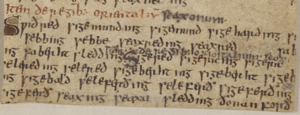Sigered of Essex facts for kids
Sigered of Essex was an important ruler in the early history of England. He was the last king of Essex, ruling from the year 798 to 825. Sigered became king after his father, Sigeric of Essex, decided to give up his throne.
Contents
Sigered's Rule and Changes
Sigered's time as king saw many changes for the kingdom of Essex. In 812, his power was reduced. He was no longer called a king but became a duke. This change happened because of his Mercian overlords, who were more powerful rulers.
Later, in 825, Sigered made another big decision. He gave up the kingdom of Essex completely to Egbert of Wessex. This meant that Essex became part of Egbert's growing kingdom.
Records of Sigered's Power
Historians have found some old records that talk about Sigered. These records suggest that Sigered might have been a "vassal" of Wessex. Being a vassal means that he was under the rule of another, more powerful king. However, these records are not always perfectly clear.
The Charter of 825
One important record is a special document called a charter. This charter was created by Egbert in 825. It gave land to a monastery in Rochester. The charter mentions Sigered as the "duke of the East Saxons". It also says that Sigered agreed to the land grant, along with other important nobles. This shows that Sigered still had some power in 825, but he was under Egbert's authority.
The Anglo-Saxon Chronicle
Another source is the Anglo-Saxon Chronicle, which is a collection of historical records. One part of the Chronicle says that in 825, Egbert of Wessex "conquered the kingdom of Kent and Sussex and Surrey and Essex". This suggests that Sigered gave up his kingdom (or duchy) to Egbert without a fight. It also supports the idea that he was a vassal.
However, another version of the Chronicle tells a slightly different story for the same year. It says that Egbert "fought against Beornwulf and the Mercians at Ellendun". After this battle, Egbert "sent his son Æthelwulf with an army into Kent". These different accounts show how historians piece together the past from various sources.


